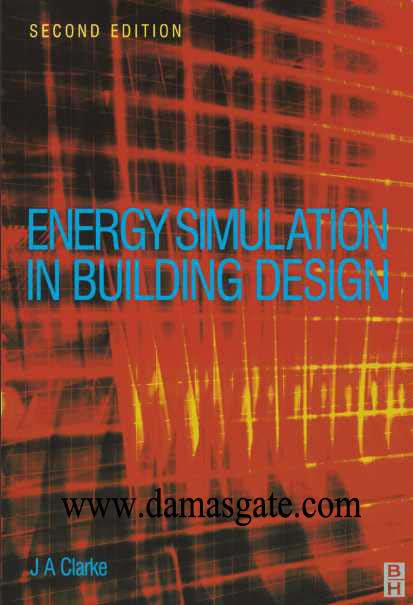Energy Simulation in Building Design

Preface
If a system can be characterised by n parameters, each of which may assume 3 independent states, then the total number of combinations is 3 n. A major problem encountered in the design of any energy systemmfrom a component such as a boiler, to a system such as a buildingmis that n is large. A building, for example, is characterised by parameters such as occupancy level, ventilation rate, degree of insulation, location of thermal capacity, glazing type, extent of HVAC provision, level of control and type of fuel, to name but a few. Even a relatively low number of parameters will give rise to a large number of combinations: n = 10 equates to 59,000! In short, energy systems are complex. To pretend otherwise is to design for certain
failure. Achieving a high quality indoor environment at acceptable cost has always presented a chal-
lenge for the construction industry. With aspects of sustainable development now being added to the list of requirements, and the growth in the available materials/systems that may be employed, this challenge is set to become even more formidable.
To add to the designer's problems, determining the merit of one combination over another is a non-trivial task requiring some means to translate the myriad physical interactions to infor- mation on cost and performance relating to fitness-for-purpose, energy use and environmental impact. Returning to the previous example: a building comprises several thermodynamic domains~air movement, radiation exchange, moisture flow, electrical power flow, daylight dis- tribution etc--each one of which may interact with the others in a non-trivial manner. For example, the simple act of adjusting the position of a window shading device will have cascad- ing effects on glare, internal daylight level, artificial lighting requirement, luminaire heat gain and space cooling, heating and electricity demand. Clearly, the construction industry has some
way to go if it wishes to incorporate a rigorous life cycle analysis into its future design practice. Given the limitations inherent in traditional design methods, is it surprising that our energy
systems often fail to attain their expected performance? Many buildings stubbornly hover at around 300 kWh m-Zyr -1, energy conversion and delivery systems operate at substantially less than their optimum efficiency, and human health and comfort needs are rarely fully satisfied.
Simulation represents a possible solution to the complexity dilemma by enabling compre- hensive and integrated appraisals of design options under realistic operating conditions. In other words, simulation supports the emulation of future realities at the design stage. It gives
practitioners the ability to appreciate the underlying behaviour of a system and, thereby, to take judicious steps to improve performance across the range of relevant criteria. To be contentious:
simulation represents a paradigm shift of vast potential. It will give rise to a cheaper, better
and quicker design process. And it will provide outcomes that better match society's aspira- tions for sustainable practices, environmental protection and climate change mitigation.
This book addresses the issues underlying the development, proving and use in practice of building energy simulation. While these issues are covered in a generic manner, the specific material derives from the ESP-r program, which has been under continuous development over a twenty five year period with financial support from the UK's Engineering and Physical Science Research Council and the R&D Framework Programmes of the European Commission. I am indebted to both organisations and to the many technical reviewers and project officers who recognised something of value in the ESP-r project.
The book has two complementary objectives: to cover theoretical aspects that will be of rele- vance to the next generation of modellers who will take the state-of-the-art to a higher plane, and to cover the use in practice aspects that will be of relevance to those practitioners who wish
to adopt a computational approach to design. I am deeply grateful to many people who, over the years, have given me guidance, support
and encouragement: Professor Tom Maver of ABACUS, who made it all possible; my col- leagues in ESRU, who create an intellectual environment that nurtures creativity and team working; to my many friends around the world whose daily aim, it sometimes seems, is to locate the pernicious software bugs upon which ESP-r is foundedt; to the memory of my mother; and to my supportive wife and children to whom I dedicate this book.
I am especially indebted to my PhD students--Essam Aasem, Ian Beausoleil-Morrison, Francesca Born, Tin-tai Chow, Stephane Citherlet, Steven Conner, Dru Crawley, Mark Evans, Jan Hensen, Apostolis Karatolios, Nick Kelly, Amissah Patrick Ken, Jae-min Kim, Iain Mac- donald, Don McLean, John MacQueen, Christoph Morbitzer, Abdul Nakhi, Cezar Negrao, Nicola Smith and Dechao Tang--who have so ably contributed to the different aspects of the integrated modelling approach, and to Jordan Denev, Milan Janak and Cor Pernot, who made important theoretical contributions.
Paul Strachan was kind enough to read the entire manuscript and give me detailed critiques, while Ian Beausoleil-Morrison, Chris Bronsdon, Andy Grant, Jon Hand, Jan Hensen, Cameron Johnstone, Nick Kelly and Lori McElroy gave me helpful advice on particular topics. Those
errors and misconceptions that remain are entirely of my own making, tt
Joe Clarke Glasgow 2001
Download
http://s18.alxa.net/s18/srvs2/01/Ene...ing.Design.rar